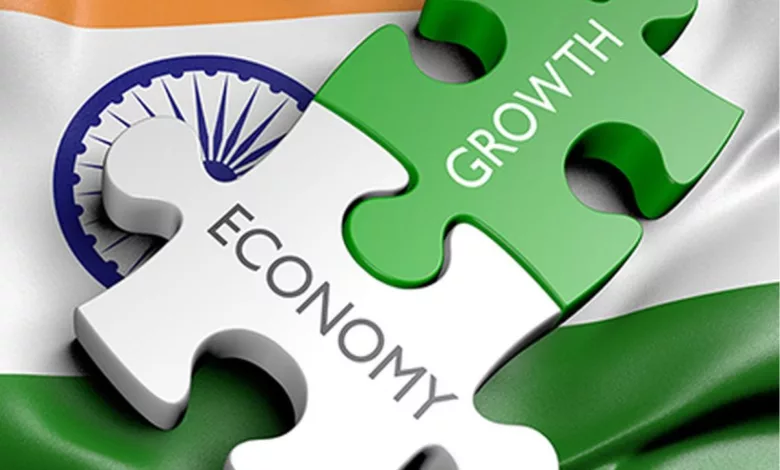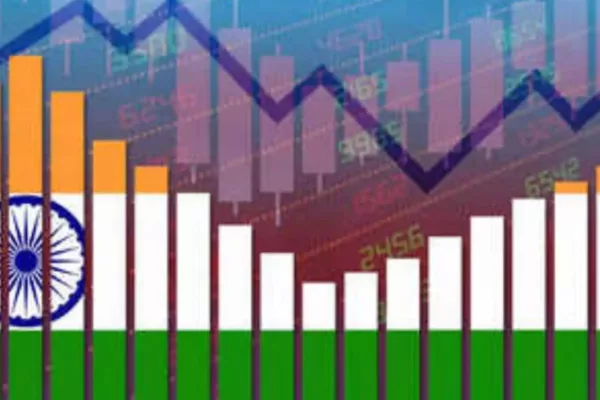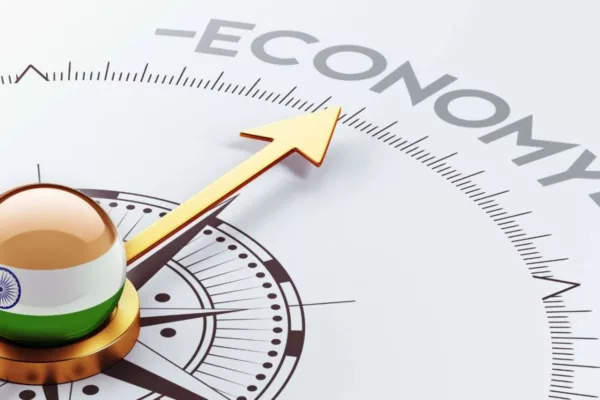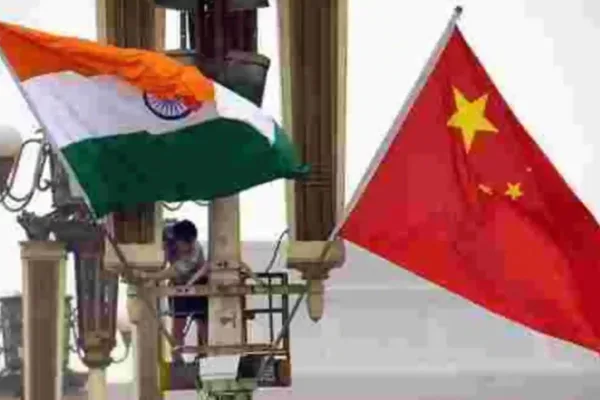India emerges as a new superpower as the global economy looks beyond China.

India emerges as a new superpower as the global economy looks beyond China.
India’s economic change is accelerating. India should become a developed country, according to Prime Minister Narendra Modi. How quickly can a nation whose reputation for bureaucracy is now a $10 trillion economy?
With Prime Minister Narendra Modi stepping aggressively to embrace the opportunity, global firms are looking beyond China. The government is investing more money than it has in at least ten years, spending close to 20% of its budget on capital projects this fiscal year.
Modi is nearer than any of his predecessors to be able to say that the country is finally reaching its economic potential. India may have just surpassed China as the world’s most populous country. To get there, he will have to contend with some of its unique disadvantages, including the lingering bureaucracy and corruption that have hindered India’s development and the democracy’s stark inequality, which is characterised by its 1.4 billion citizens.
One of the biggest technology services firms in the country, Infosys Ltd., was founded by Nandan Nilekani. He stated that “India is on the verge of massive change.” A few billion smartphones, tens of thousands of companies, and some of the lowest data rates in the world can all be supported by India, according to him.
A positive force is the US-China competition. According to supply-chain analysts, India and Vietnam will gain significantly as businesses adopt a “China-plus-one” strategy.
Three significant Taiwanese suppliers to Apple Inc. have benefited from Modi’s government’s incentives to increase smartphone production and exports. From April through December, iPhone shipments more than doubled to reach $2.5 billion.

Finding a country that can drive the global economy is becoming more important as economies from China to Germany struggle with slower growth. According to Morgan Stanley, India will drive a fifth of global growth in this decade, making it one of only three countries capable of producing more than $400 billion in annual output growth.
Global equity markets have mirrored this notion, with India’s Sensex index trading at its highest level in ten years in comparison to the S&P 500 last quarter. Indian stock prices have never been higher when compared to other emerging markets.
In the coming decade, “people are looking at whatever another place is going to be a wonderful place to deposit capital,” Nilekani added. It has been 15 years since I last noticed this level of attention in India.
Of course, Modi’s ambitions in the industrial sector are not new. In 2014, he launched his “Make in India” campaign to follow the lead of China and the East Asian tigers, including Singapore, South Korea, and Taiwan, which rose to the top of the economic ladder by staffing factories with people who produced goods that consumers wanted to buy.
One of the program’s core metrics, increasing manufacturing to 25% of GDP, has been difficult to achieve. According to data from McKinsey, the ratio increased from 15.3% in 2000 to 17.4% in 2020. During the same period, the GDP share of Vietnam’s factory sector more than doubled.
But India has momentum because it is the G-20 president this year. Despite pressure from Washington, the country increased its purchases of Russian oil by 33 times thanks to a foreign strategy based on various alliances and unabashed self-interest.
More than a dozen of Apple’s Chinese suppliers are gaining preliminary approval from New Delhi to expand operations, supporting the tech giant’s aspirations to shift production to India. This is one of the few signs of pragmatism in the contentious relationship with China’s neighbour.
According to former US ambassador to India Kenneth Juster, India’s adoption of a middle route has improved its reputation as a country “with which everyone is interested in having a positive relationship.”
To build a bridge between east and west and north and south, he claimed, India is positioning itself and using its G-20 chairmanship to accomplish so. Many businesses believe that India is the place where it should be because of its size, its youthful population, and its unavoidable influence in world affairs.
Modi challenged the country to aim to “dominate the world” in a speech he gave in August to mark the anniversary of India’s independence. He declared at the Red Fort in New Delhi, periodically striking the air with clenched fists, “We must vow to make India a developed nation in the next 25 years.” Before he spoke, flower petals were dropped from helicopters upon the audience.
According to Bloomberg Economics, the country’s per capita income will catch up to certain wealthy nations within that time, making Modi’s objective attainable.

According to BE, the privatisation of state assets, incentives for manufacturers, and corporate tax cuts will cause the potential GDP growth to gradually reach a high at around 8.5% in the early part of the next decade. According to the Centre for Economics and Business Research, India’s economy will reach $10 trillion by 2035.
Confronting bureaucracy
Modi will have to overcome the legacies of India’s early years as an independent country, which included decades of missed economic opportunities if he is to achieve his goal.
India became more inward-looking following the British subcontinental division in 1947 and the ensuing religious conflict. By the 1970s, a large portion of the economy had been nationalised, and the world had been cut off by a formidable bureaucracy. Everything, from car models to the kinds of bread that were allowed in stores, was governed by the complex “License Raj” system.
The change was compelled by a balance of payments crisis in 1991. Manmohan Singh, the country’s then-finance minister, supported depreciating the rupee and welcoming foreign investment in response to the country’s declining foreign exchange reserves and pressure from the IMF.
The reforms were difficult to sell. However, by the decade’s close, it was clear that India’s economic climate had changed. The GDP almost doubled. New options were provided by international companies like Microsoft and McDonald’s. India saw growth of close to 8% for several years in the 2000s.
Voters anticipated “Ronald Reagan on a white horse” when Modi came to office in 2014, running on the platform of “minimal government, maximum governance,” and saw a chance to advance liberalisation.
The new prime minister of India, whose father was a tea vendor, vowed to remove any residual vestiges of the License Raj, including the practice of accepting bribes in exchange for access to government services.
Modi presented himself as a political outsider with managerial skill, prepared to use his expertise to lead Gujarat, one of the country’s most industrialised states, to steer India toward top-down development, similar to China.
He has made great progress, particularly in the area of infrastructure. Since Modi’s election victory in 2014, India’s national highway network has increased in length by more than 50%, domestic air travel has roughly doubled, and a massive biometric system has assisted hundreds of millions of individuals in opening bank accounts for the first time.
Forging a single economic zone out of India’s overlapping federal and state levies is one of Modi and his Bharatiya Janata Party’s most celebrated accomplishments. This may be the most critical move since 1991. By increasing 34% from the year before, tax revenue collection reached a record high in 2017. The government will release its spending plan for the upcoming fiscal year on February 1.
According to Adar Poonawalla, the chief executive of the Serum Institute of India, one of the biggest vaccine producers in the world, streamlining India’s economy has “introduced a lot more openness in the system.” “Look at the current collection. The amount of money the government receives is double or treble what it was under the previous administration.
When Modi banned almost all local currency bills in 2016 to combat corruption and tax evasion, the reaction was less warm. Indians who depended on daily cash wages were shattered by the shocking disclosure.
And Modi encountered another roadblock when he extended his liberalisation push to the agricultural industry, which accounts for around 5% of the economy. Following massive protests that saw hundreds of farmers camp on the outskirts of the capital for months, sweeping reforms were abandoned in 2021.
To revolutionise India the way Margaret Thatcher revolutionised Britain, according to the author and former chief executive of Procter & Gamble India Gurcharan Das, Modi still has a lot to prove.
The fact that Indian voters, many of whom still live on little than a few dollars a day, prefer concrete political promises like free energy to more generalised measures to promote investment is a difficulty.

Since the reforms haven’t been advertised in India, many people believe they would make the rich richer and the poor poorer. Nevertheless, Sanjeev Sanyal, an economic adviser to Modi’s government, exuded confidence and described these problems as teething problems that would affect any young nation.
He stated that India’s goals for the following 25 years are increasing supply-side productivity, fostering creative destruction, and maintaining the reduction of absolute poverty. Sanyal declared, “We are finally releasing the bureaucratic shackles in our heads.
Growing Unfairness
According to estimates from the World Population Review, India had 1.417 billion people as of the end of last year, which is around 5 million higher than China has stated. The milestone is anticipated to be reached by India later this year, according to the UN.
In contrast to China, whose residents are fast getting older and whose population dropped in 2022 for the first time since the final year of the Great Famine in the 1960s, half of India’s population is under the age of 30.
India’s middle class continues to be much smaller, among other major contrasts. The nation’s demographic dividend, which is possibly its strongest advantage over countries with larger populations, must be fully realised to address the high rates of unemployment among women, minorities, and young people. This requires greater wealth development.
Duvvuri Subbarao, a former governor of the Reserve Bank of India, stated that “if we do not address inequality, we can’t get very far with growth.” India is the only country where the ultra-wealthy are growing at a greater rate, evoking analogies to the heyday of the Gilded Age in America.
In comparison to the US, the wealth disparity between the top 1% of earners and the poorest 50% of earners has increased significantly since 1995, almost three times as much.
More unicorns, unlisted businesses worth at least $1 billion, are being created by a new breed of entrepreneurs than by any other country outside the US and China. As a result of their increasing success, real estate prices in the hotspots of Mumbai and Bangalore are rising, and companies ranging from UBS Group AG to Deutsche Bank AG are hiring more private bankers.
However, one estimate indicates that the pandemic was a contributing factor in the decline of female labour force participation to 9% by 2022. According to Bloomberg Economics research, closing the gender gap by 58 percentage points by 2050 could increase India’s GDP by more than 30%.
Additionally underrepresented is India’s sizable Muslim minority. Despite making up 14% of the population, they are thought to be employed in only 7% of public sector positions.
Critics of the government worry that hardline officials who have pushed for India to formally remake itself as a Hindu nation are undermining the secular foundation of the country as well as the economic potential of over 300 million members of its religious minority.
Before entering politics, Modi spent many years working for a Hindu-right organisation. According to Harsh Mander, a social activist and the creator of the Centre for Equity Studies, a research group in New Delhi, “a big segment of our people live more and more in a form of continual insecurity.” He claimed that this dynamic “would be stifling for a secure investment.”
Industrial Dreams of India
The government is attempting to create chances for all Indians, according to Sanyal, the economic adviser to Modi’s administration, and it would be wrong to hold one leader accountable for persistent problems.
A primary priority continues to be increasing manufacturing to a quarter of GDP and creating plenty of jobs that would follow. India’s share of world trade is less than 2%, yet in the most recent fiscal year, its exports of goods surpassed a record $400 billion.
The government is offering more than $24 billion in incentives over the following several years in more than a dozen industries to compete with China.
A portion of the funds will go toward the manufacturing of solar panels by Reliance Industries Ltd., semi-conductors by Hon Hai Precision Industry Co., and mobile phone handsets by Wistron Corp. and Samsung Electronics Co. Manufacturers of electrolyzers and other necessary machinery for the production of green hydrogen will be included in the programme in the upcoming months.
The next phase is to increase production outside of the largest manufacturers in the world.
Building scale in India can be challenging, according to Shiv Bhargava, the founder of Viraj Exports, a mid-sized garment exporter. Bhargava manoeuvred between sewing stations at his facility in Noida, an industrial area, where employees sewed clothes for the Zara clothing chain.
He employs roughly 1,000 people nationwide, but he claims the number would be higher if not for the country’s somewhat onerous labour rules. The state governments of several states have reacted angrily to Modi’s attempts to simplify the laws.
Our costs are 40% to 50% higher than in Bangladesh, according to Bhargava. “Workers have the choice to have better options when a country’s economy improves.”
Some younger Indians are delaying employment rather than working in factories because they want to work in white-collar jobs. Under-30s make up around half of the potential labour force and aren’t even seeking work.
The figures are also explained by shifting employment trends, particularly in India’s rural regions, where the majority of the country’s population resides. Workers in Haryana, a significant farming state, have been compelled to move from towns to urban areas due to the disappearance of agricultural jobs.
Kusum, a young woman who lost her job as a teacher due to the pandemic, claimed liberalisation has helped the Mundakhera community. She was perched on a rope cot. Now, her family can purchase a motorcycle and washing machine. She checks Google on her smartphone first thing in the morning to look up job openings and keep up with the news.
According to her, India must act more quickly to provide her generation with skills that are viable in a more globalised economy as farming diminishes. In Mundakhera, where orderly brick homes encircle a pond covered in algae, high-quality jobs are currently harder to come by. She remarked, “The private sector needs that because our education is not skill-based.”
Future-building for India
The business elite in India is upbeat despite these challenges. Entrepreneurs are keen to take advantage of increased consumer spending, a higher risk tolerance among consumers, and a thriving environment for digital companies.
Young employees are busy filming content using beauty kits at Nykaa’s spacious offices in Mumbai. More than 100 brick-and-mortar stores are operated by the company, which is India’s top e-commerce site for beauty products.
The “banana peels” that businesspeople used to step on have been removed, according to Falguni Nayar, a former banker who founded Nykaa with her daughter in 2012.
According to her, developments like the reduction of taxes on high-end goods were advantageous to the sector. Nykaa’s successful initial public offering in 2021 helped Nayar become the richest self-made woman in the nation by raising 53.5 billion rupees (about $660 million).
We’ll surpass China to become the third-largest economy in the world, she said. Frequently, people question Nayar if urban areas experience higher consumption than rural ones. No more, she remarked. “If earlier we used to see fans, now they’ll have air conditioners and refrigerators,” the saying goes in many communities.
Considering how well-liked he is, Modi has a chance to make changes that most world leaders would envy. The prime minister consistently receives approval ratings above 70%.
In an unusual gesture to reduce sectarian tensions as he gets ready to host the G-20 conference, Modi this month asked members of his ruling party to engage with Muslims and other religious minorities. The question of how much economic desire will influence Modi’s agenda and how he uses his political capital is on the horizon with national elections scheduled for 2024.
The CEO of the Serum Institute of India, Poonawalla, expressed optimism. India is doing quite well despite supply chain disruption, rising oil costs, inflation, and the war issue.
edited and proofread by nikita sharma




